1998 PONTIAC BONNEVILLE fuses
[x] Cancel search: fusesPage 74 of 395
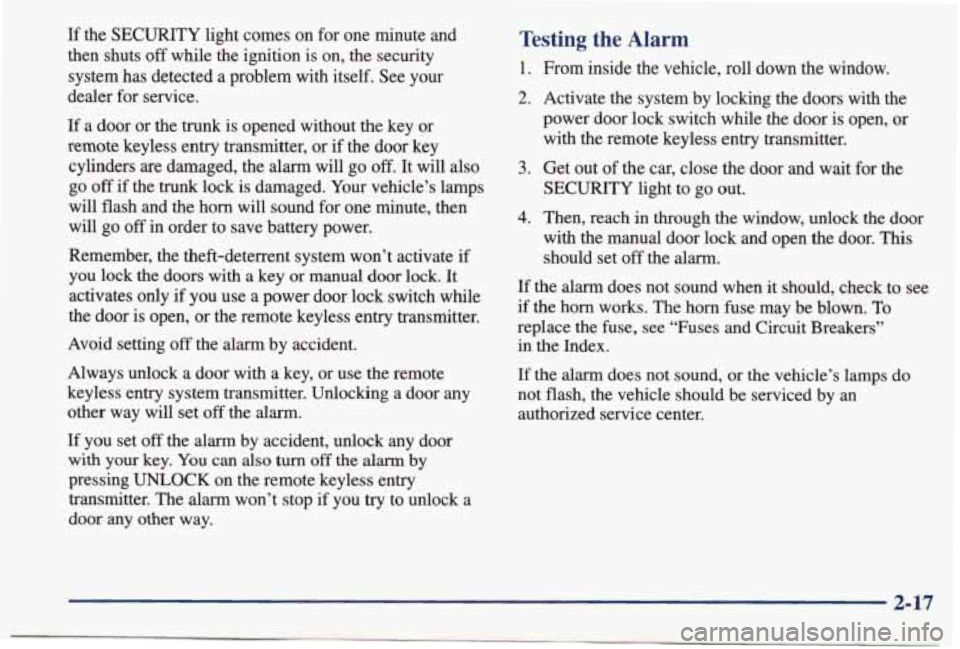
If the SECURITY light comes on for one minute and
then shuts
off while the ignition is on, the security
system has detected a problem with itself. See your
dealer for service.
If a door or the trunk is opened without the key or
remote keyless entry transmitter, or if the door key
cylinders are damaged, the alarm will go
off. It will also
go
off if the trunk lock is damaged. Your vehicle’s lamps
will flash and the horn will sound for one minute, then
will go off in order to save battery power.
Remember, the theft-deterrent system won’t activate
if
you lock the doors with a key or manual door lock. It
activates only
if you use a power door lock switch while
the door is open, or the remote keyless entry transmitter.
Avoid setting
off the alarm by accident.
Always unlock
a door with a key, or use the remote
keyless entry system transmitter. Unlocking
a door any
other way will set
off the alarm.
If you set off the alarm by accident, unlock any door
with your key. You can also turn off the alarm by
pressing UNLOCK on the remote keyless entry
transmitter. The alarm won’t stop if you
try to unlock a
door any other way.
Testing the Alarm
1. From inside the vehicle, roll down the window.
2. Activate the system by locking the doors with the
power door lock switch while the door is open, or
with the remote keyless
entry transmitter.
3. Get out of the car, close the door and wait for the
SECURITY light to
go out.
4. Then, reach in through the window, unlock the door
with the manual door lock and open the door.
This
should set off the alarm.
If the alarm does not sound when it should, check to see
if the horn works. The horn fuse may be blown.
To
replace the fuse, see “Fuses and Circuit Breakers”
in the Index.
If the alarm does not sound,
or the vehicle’s lamps do
not flash, the vehicle should be serviced by an authorized service center.
Page 75 of 395
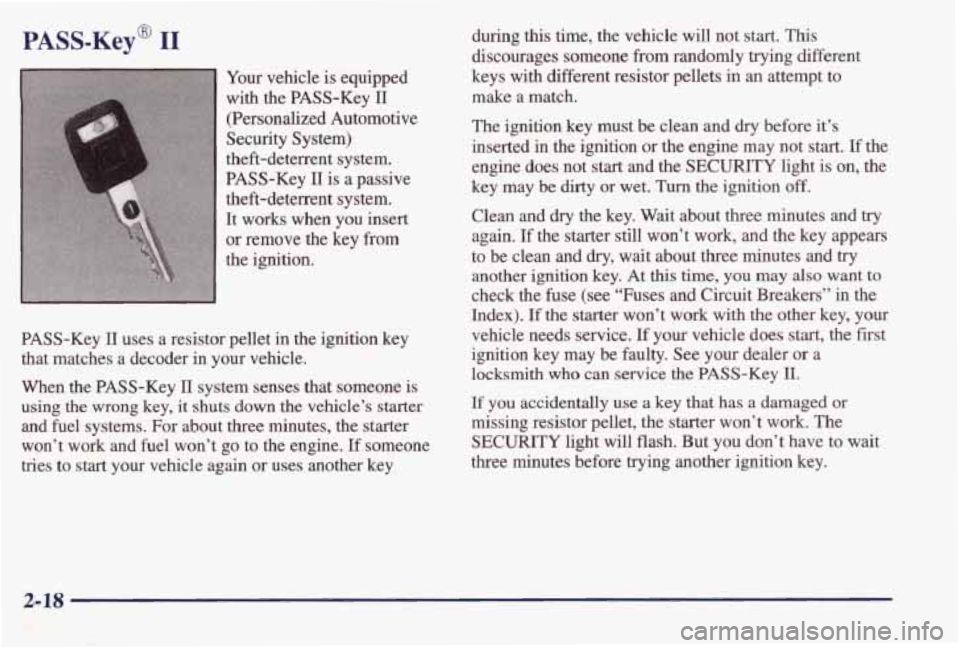
PASS-Key@ I1
Your vehicle is equipped
with the PASS-Key
11
(Personalized Automotive
Security System)
theft-deterrent system.
PASS-Key
II is a passive
theft-deterrent system.
It works when you insert
or remove the key from
the ignition.
PASS-Key
11 uses a resistor pellet in the ignition key
that matches a decoder in your vehicle.
When the PASS-Key
11 system senses that someone is
using
the wrong key, it shuts down the vehicle’s starter
and fuel systems. For about three minutes, the starter
won’t work and fuel won’t go to the engine.
If someone
tries
to start your vehicle again or uses another key during
this time, the vehicle will not start. This
discourages someone from randomly trying different
keys with different resistor pellets in
an attempt to
make a match.
The ignition key must be clean and
dry before it’s
inserted in the ignition or the engine may not start.
If the
engine does not
start and the SECURITY light is on, the
key may be
dirty or wet. Turn the ignition off,
Clean and dry the key. Wait about three minutes and try
again. If the starter still won’t work, and the key appears
to be clean and
dry, wait about three minutes and try
another ignition key. At this time, you may also want to
check the
fuse (see “Fuses and Circuit Breakers” in the
Index).
If the starter won’t work with the other key, your
vehicle needs service.
If your vehicle does start, the first
ignition key may be faulty. See your dealer
or a
locksmith who can service
the PASS-Key II.
If you accidentally use a key that has a damaged or
missing resistor pellet, the starter won’t work. The
SECURITY light will flash. But you don’t have to wait
three minutes before trying another ignition
key.
Page 94 of 395
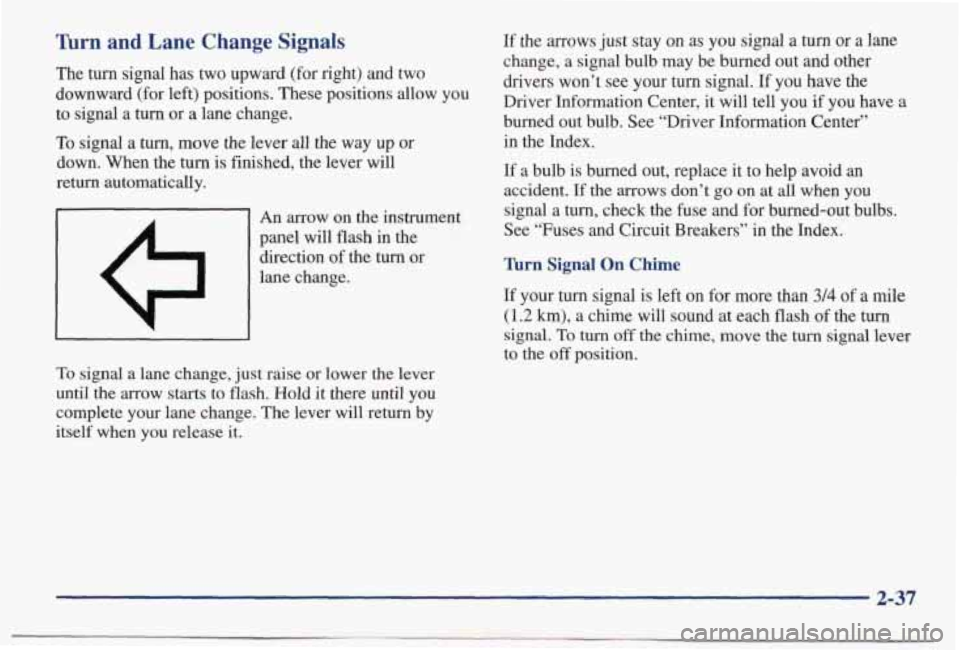
Wrn and Lane Change Signals
The turn signal has two upward (for right) and two
downward (for left) positions. These positions allow you
to signal a turn or
a lane change.
To signal a turn, move the lever all the way up or
down. When the turn is finished, the lever will
return automatically,
CII
An arrow on the instrument
panel will flash in the
direction of the
turn or
lane change.
To signal a lane change, just raise or lower the lever
until the arrow starts to flash. Hold it there until
you
complete your lane change. The lever will return by
itself when you release
it.
If the arrows just stay on as you signal a turn or a lane
change, a signal bulb may be burned out and other
drivers won’t see your turn signal. If
you have the
Driver Information Center, it will tell
you if you have a
burned out bulb. See “Driver Information Center”
in the Index.
If a bulb
is burned out, replace it to help avoid an
accident. If the arrows don’t go on at all when you
signal a turn, check the fuse and for burned-out bulbs.
See “Fuses and Circuit Breakers” in the Index.
Tbrn Signal On Chime
If your turn signal is left on for more than 3/4 of a mile
(1.2 km), a chime will sound at each flash of the turn
signal.
To turn off the chime, move the turn signal lever
to the
off position.
2-37
Page 134 of 395
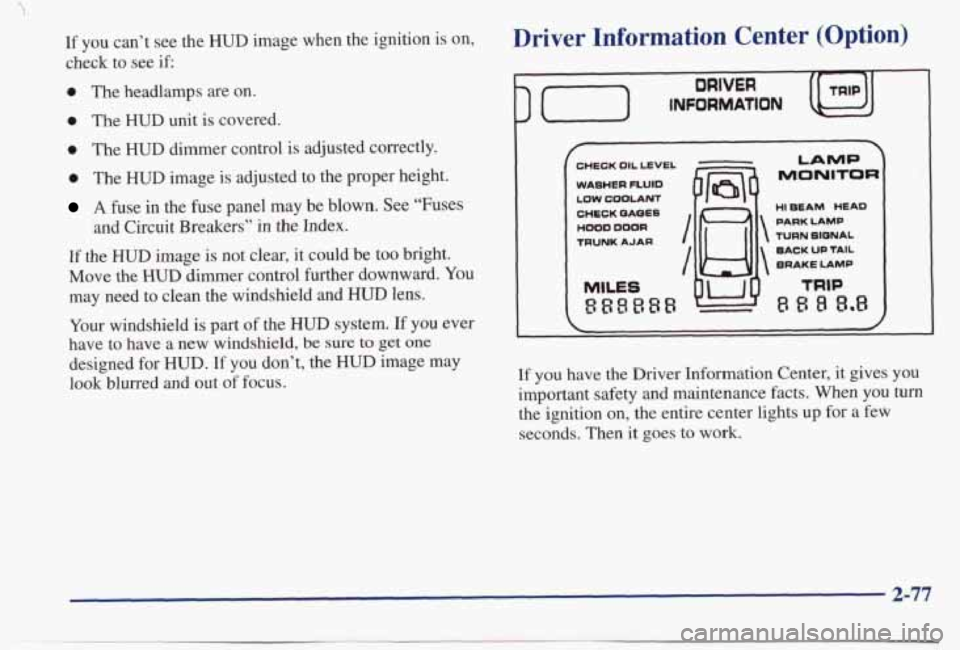
If you can’t see the HUD image when the ignition is on,
check to see if:
0 The headlamps are on.
0 The HUD unit is covered.
0 The HUD dimmer control is adjusted correctly.
0 The HUD image is adjusted to the proper height.
A fuse in the fuse panel may be blown. See “Fuses
and Circuit Breakers” in the Index.
If the HUD image is not clear, it could be too bright.
Move the HUD dimmer control further downward. You
may need to clean the windshield and
HUD lens.
Your windshield is part of the HUD system. If you ever
have to have a new
windshield, be sure to get one
designed for HUD. If you don’t, the HUD image may
look blurred
and out of focus.
Driver Information Center (Option)
DRIVER
CHECK OIL LEVEL
WABHER
FLUID
LOW COOLANT
CHECK WE8
HOOD DOOR
TRUNK
AJAR
MILES
888888
m
LAMP
MONITOR
HI BEAM HEAD
PARK
LAMP
TURN WONAL
BACK UP TAIL
BRAKE LAMP
TRIP
8 s 8 8.8
If you have the Driver Information Center, it gives you
important safety and maintenance facts.
When you turn
the ignition on, the entire center lights up for a few
seconds. Then it goes
to work.
2-77
Page 310 of 395
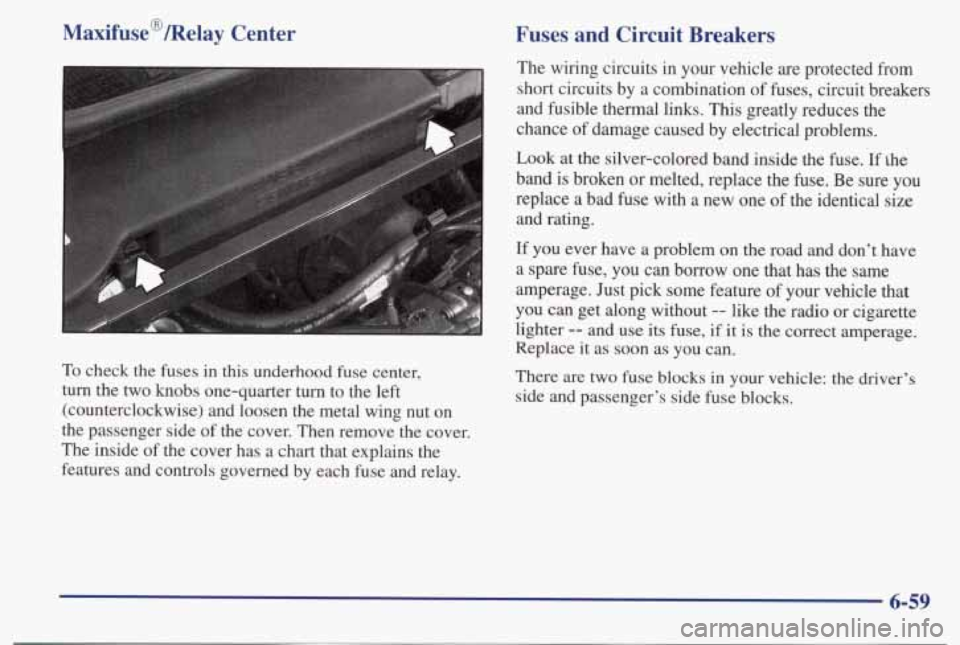
Maxifuse@/Relay Center
To check the fuses in this underhood fuse center,
turn the two
knobs one-quarter turn to the left
(counterclockwise) and loosen the metal wing
nut on
the passenger side of the cover. Then remove the cover.
The inside of the cover has
a chart that explains the
features and controls governed
by each fuse and relay.
Fuses and Circuit Breakers
The wiring circuits in your vehicle are protected from
short circuits by a combination of fuses, circuit breakers
and fusible thermal links. This greatly reduces the
chance
of damage caused by electrical problems.
Look at the silver-colored band inside the fuse. If
the
band is broken or melted, replace the fuse. Be sure you
replace a bad fuse with
a new one of the identical size
and rating.
If you ever have a problem on the road and don't have
a spare fuse,
you can borrow one that has the same
amperage. Just pick some feature
of your vehicle that
you
can get along without -- like the radio or cigarette
lighter
-- and use its fuse, if it is the correct amperage.
Replace
it as soon as you can.
There
are two fuse blocks in your vehicle: the driver's
side and passenger's side fuse blocks.
6-59
Page 311 of 395
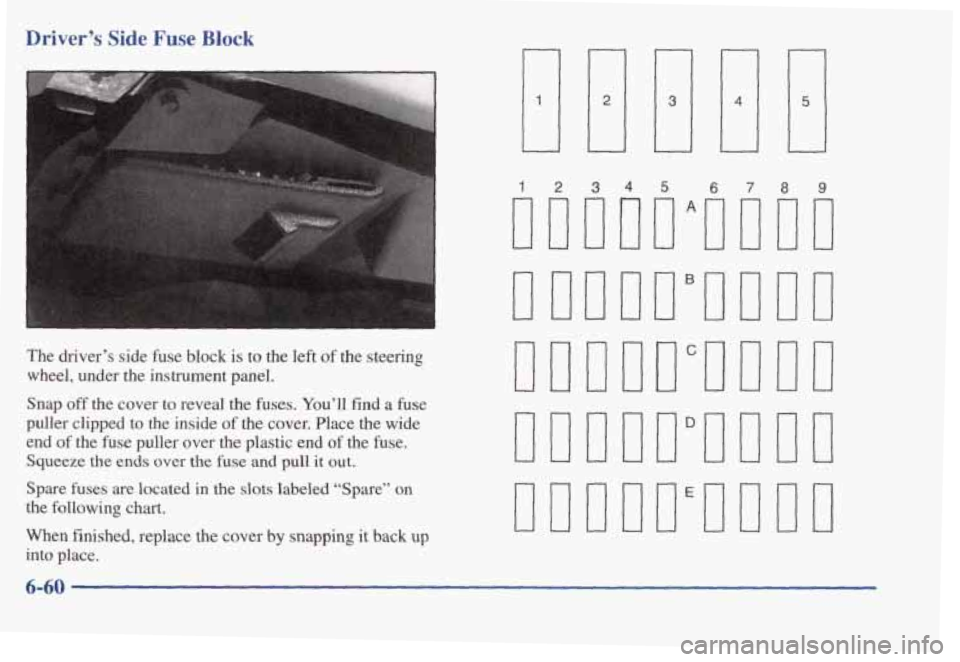
Driver’s Side Fuse Block
The driver’s side fuse block is to the left of the steering
wheel, under the instrument panel.
Snap
off the cover to reveal the fuses. You’ll find a fuse
puller clipped
to the inside of the cover. Place the wide
end of the fuse puller over the plastic end
of the fuse.
Squeeze
the ends over the fuse and pull it out.
Spare fuses are located
in the slots labeled “Spare” on
the following chart.
When finished, replace the cover
by snapping it back up
into place.
12345 6789
Page 313 of 395
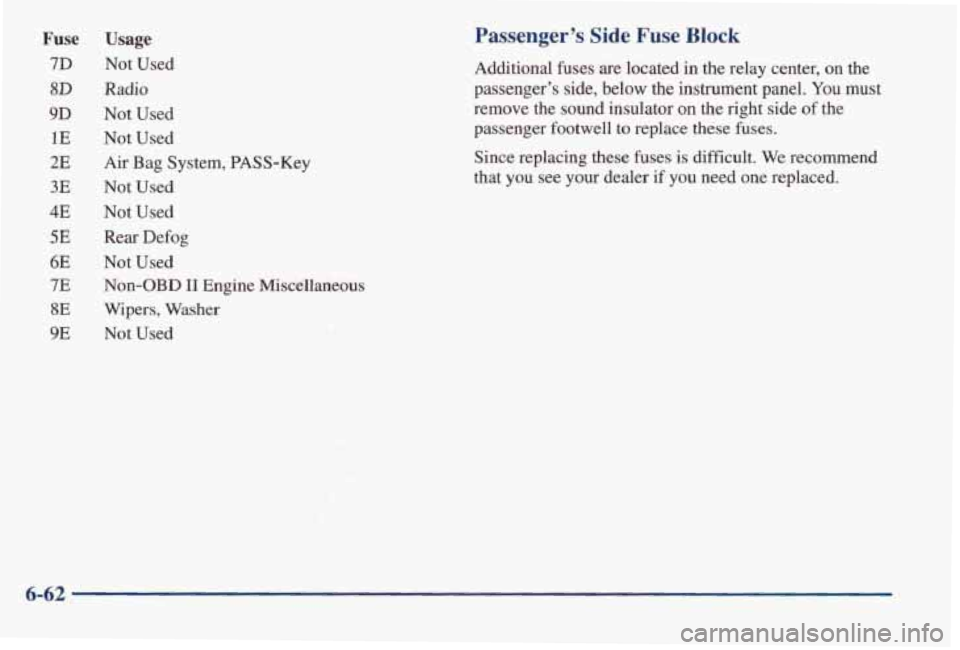
Fuse
7D
8D
9D
1E
2E
3E
4E
5E
6E
7E
8E
9E
Usage
Not Used
Radio
Not Used
Not Used
Air
Bag System, PASS-Key
Not Used
Not Used Rear Defog
Not Used Non-OBD
II Engine Miscellaneous
Wipers, Washer
Not Used
Passenger’s Side Fuse Block
Additional fuses are located in the relay center, on the
passenger’s side, below the instrument panel. You must
remove the sound insulator
on the right side of the
passenger footwell
to replace these fuses.
Since replacing these fuses is difficult. We recommend
that you see your dealer
if you need one replaced.
6-62
Page 375 of 395
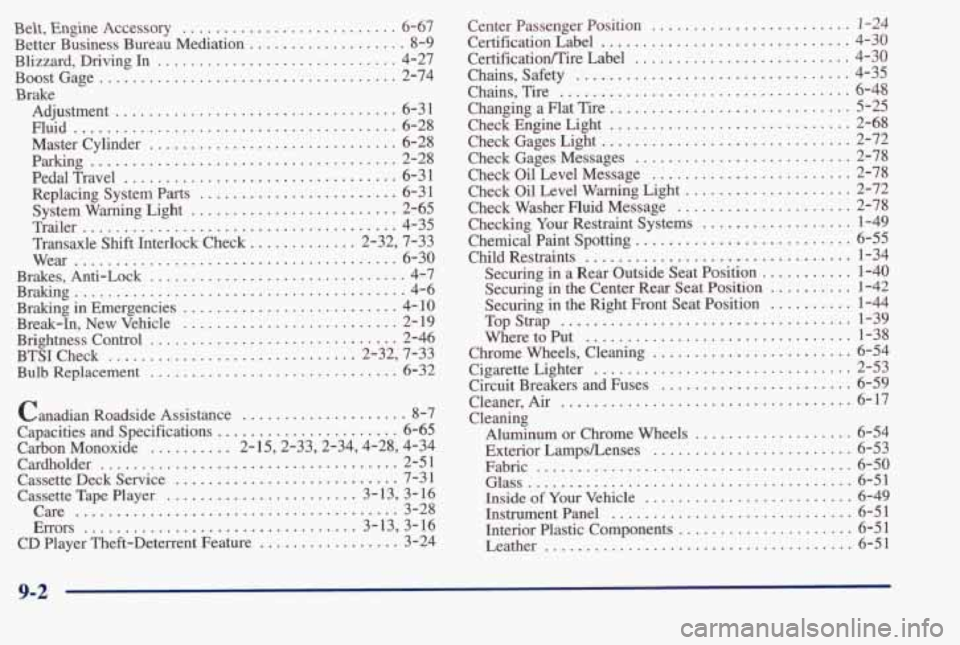
Belt. Engine Accessory .......................... 6-67
Better Business Bureau Mediation
................... 8-9
Blizzard. Driving In
............................. 4-27
Boost Gage
.................................... 2-74
Adjustment
.................................. 6-3 1
Master Cylinder
.............................. 6-28
Parking ..................................... 2-28
Pedal Travel
................................. 6-3 1
Replacing System Parts
........................ 6-31
System Warning Light
......................... 2-65
Trailer
...................................... 4-35
Transaxle
Shift Interlock Check ............. 2-32. 7-33
Wear
....................................... 6-30
Brakes.Anti -Lock ............................... 4-7
Braking
........................................ 4-6
Braking in Emergencies
.......................... 4- 10
Break-In.
New Vehicle .......................... 2- 19
Brightness Control
.............................. 2-46
BTSI Check
.............................. 2-32, 7-33
Bulb Replacement
.............................. 6-32
Brake
Fluid
....................................... 6-28
Canadian Roadside Assistance
.................... 8-7
Capacities and Specifications
...................... 6-65
Carbon Monoxide
.......... 2.15.2.33.2.34.4.28. 4.34
Cardholder
.................................... 2-51
Cassette Deck Service ........................... 7-31
Cassette Tape Player
....................... 3-13. 3-16
Care
....................................... 3-28
Errors
................................. 3-13, 3-16
CD Player Theft-Deterrent Feature ................. 3-24 Center Passenger Position
. . , ........ ..... 1-24
CertificationLabel .............................. 4-30
CertificationEire Label
.......................... 4-30
Chains, Safety
................................. 4-35
Chains, Tire
................................... 648
Changing a Flat Tire .............................. 5-25
Check Engine Light
............................. 2-68
Check Gages Light
.............................. 2-72
Check Gages Messages
.......................... 2-78
Check Oil Level Message
........................ 2-78
Check
Oil Level Warning Light .................... 2-72
Check Washer Fluid Message
..................... 2-78
Checking
Your Restraint Systems .................. 1-49
Chemical Paint Spotting
.......................... 6-55
Securing
in the Center Rear Seat Position .......... 1-42
ChildRestraints ................................ l-34
Securing in a Rear Outside Seat Position ........... 1-40
Securing
in the Right Front Seat Position .......... 1-44
TopStrap ................................... 1-39
WheretoPut
................................ l-38
Chrome Wheels, Cleaning ........................ 6-54
Cigarette Lighter
............................... 2-53
Circuit Breakers and Fuses
....................... 6-59
Cleaner,
Air ................................... 6-17
Cleaning Aluminum or Chrome Wheels
................... 6-54
Exterior Lamps/Lenses
........................ 6-53
Fabric
...................................... 6-50
Glass
....................................... 6-51
Inside
of Your Vehicle ......................... 6-49
Instrument Panel ............................. 6-51
Interior Plastic Components
..................... 6-51
Leather
..................................... 6-51
9-2